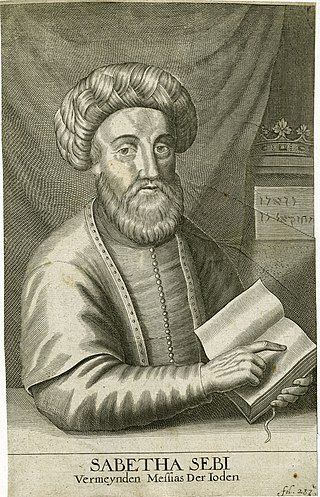Related Research Articles

The Sabbateans were a variety of Jewish followers, disciples, and believers in Sabbatai Zevi (1626–1676), an Ottoman Jewish rabbi and Kabbalist who was proclaimed to be the Jewish Messiah in 1666 by Nathan of Gaza.

Jacob Joseph Frank was a Polish-Jewish religious leader who claimed to be the reincarnation of the self-proclaimed messiah Sabbatai Zevi (1626–1676) and also of the biblical patriarch Jacob. The Jewish authorities in Poland excommunicated Frank and his followers due to his heretical doctrines that included deification of himself as a part of a trinity and other controversial concepts such as neo-Carpocratian "purification through transgression".

Sabbatai Zevi was an Ottoman Jewish mystic, and ordained rabbi from Smyrna. His family origins may have been Ashkenazi or Spanish. Active throughout the Ottoman Empire, Zevi claimed to be the long-awaited Jewish Messiah and founded the Sabbatean movement.
Mordecai Mokiach was a Jewish Sabbatean prophet and Messiah claimant.

Isaac Aboab da Fonseca was a rabbi, scholar, kabbalist, and religious writer. In 1656, he was one of several elders within the Portuguese-Jewish community in Amsterdam and for a time in Dutch Brazil before the Portuguese reconquest. He was one of the religious leaders who excommunicated philosopher Baruch Spinoza in 1656.

The Dönme were a group of Sabbatean crypto-Jews in the Ottoman Empire who were forced to convert to Islam, but retained their Jewish faith and Kabbalistic beliefs in secret. The movement was centered mainly in Thessaloniki. It originated during and soon after the era of Sabbatai Zevi, a 17th-century Sephardic Jewish Rabbi and Kabbalist who claimed to be the Jewish Messiah and eventually feigned conversion to Islam under threat of death from the Sultan Mehmed IV. After Zevi's forced conversion to Islam, a number of Sabbatean Jews purportedly converted to Islam and became the Dönme. Some Sabbateans lived on into 21st-century Turkey as descendants of the Dönme.

Nathan of Gaza, also Nathan Benjamin ben Elisha Hayyim haLevi Ashkenazi or Ghazzati, was a theologian and author born in Jerusalem. After his marriage in 1663 he moved to Gaza, where he became famous as a prophet for the Jewish messiah claimant Sabbatai Zevi.
Abraham Miguel Cardozo was a Sabbatean prophet and physician born in Rio Seco, Spain.

Abraham Yachini was one of the chief agitators in the Sabbatean movement, the son of Pethahiah of Constantinople.
Rabbi Samuel ben Abraham Aboab also known by his acronym RaSHA was a 17th-century Western Sephardic rabbi and scholar, who is considered to be one of the greatest rabbinic sages of Italy. He served as the av bet din of Venice, where he rose to great prominence due to his vast knowledge of rabbinic literature. He is known for being an adamant opponent of the Sabbatean movement, and an early supporter of the old Yishuv.
Moses Pinheiro was an Italian Jew who lived in Livorno in the seventeenth century. He was one of the most influential pupils and followers of Sabbatai Zevi.
Abraham ben Levi Conque,(Hebrew: אברהם בן לוי קונקי) also spelt Konki and Cuenque, was a 17th-century rabbi and kabbalist in Hebron.
Behr Shmuel Issachar Leyb ben Judah Moses Eybeschuetz Perlhefter was a Jewish scholar and rabbi. His educated wife Bella bat R. Jakob Perlhefter, corresponded in Hebrew and wrote the preface on the Yiddish book “Beer Sheva”. Perlhefter taught the German Christian Hebraist Johann Christoph Wagenseil Hebrew and Jewish literature. Beer Perlhefter is considered an important figure of the Sabbatian movement. After the death of the pseudo-Messiah Sabbatai Zevi (1626-1676), he restored the Sabbatian theology at the school of Abraham Rovigo and called the Pseudomessiah Mordecai Mokiach to Italy.
Abraham Pereyra was a wealthy and prominent Portuguese Jewish merchant, who lived in Amsterdam from circa 1644 to his death in 1699.
Abraham Rovigo was a Jewish scholar, rabbi and kabbalist.
Samuel Primo, was a prominent Sabbatean sectarian of the 17th century.
Hemdat Yamim is a book dealing with Jewish customs and laws, including many musar exhortations. It is based on kabbalah in general, and the kabbalah of the Ari in particular.
Mattithiah ben Benjamin Ze'ev (Wolf) Ashkenazi Bloch was a 17th-century Sabbatean Kabbalist. He was appointed by Sabbatai Zevi as one of his prophets charged with the announcement of the Redemption.
Leyb ben Oyzer or Yehuda Leib ben Ozer Rosencranz (Rosenkrantz), or Leib ben Rabbi Oizers (d. 1727) was an 18th-century shamash ha-kehilla (beadle or sexton of the congregation), trustee, and secretary or notary, of the Jewish community in Amsterdam. He is the author of the Bashraybung fun Shabsai Tsvi, a Yiddish chronicle written in 1718 about the messianic Sabbateanism movement.
References
- ↑ Manasseh ben Israel; Henry Méchoulan; Gérard Nahon (May 1987). The Hope of Israel. Published for the Littman Library by Oxford University Press. p. 137. ISBN 978-0-19-710054-7 . Retrieved 2 May 2011.
- ↑ Yaari, Avraham (2007). "Meir ben Ḥiyya Rofe". In Berenbaum, Michael; Skolnik, Fred (eds.). Encyclopaedia Judaica . Vol. 13 (2nd ed.). Detroit: Macmillan Reference. p. 783-784. ISBN 978-0-02-866097-4 – via Gale Virtual Reference Library.
- ↑ Scholem, Gershom, Sabbatai Sevi: The Mystical Messiah: 1626–1676, Princeton University Press, Princeton, 1973, p. 887, states that Meir Rofe of Hebron had left Palestine together with Nathan of Gaza in 1666, and that he was "a member of Nathan's intimate circle in Adrianople..." Both Nathan and Abraham Rovigo were known Kabbalists, as was Rofe's father who studied Kabbalah with Hayyim Vital in Safed, where Rofe was born.
- ↑ Scholem, Sabbatai Sevi, p. 888.
- ↑ Scholem, Sabbatai Sevi, p. 771. This correspondence was published by Isaiah Tishby in Sefunot, III-IV (1960), pp. 71-130.